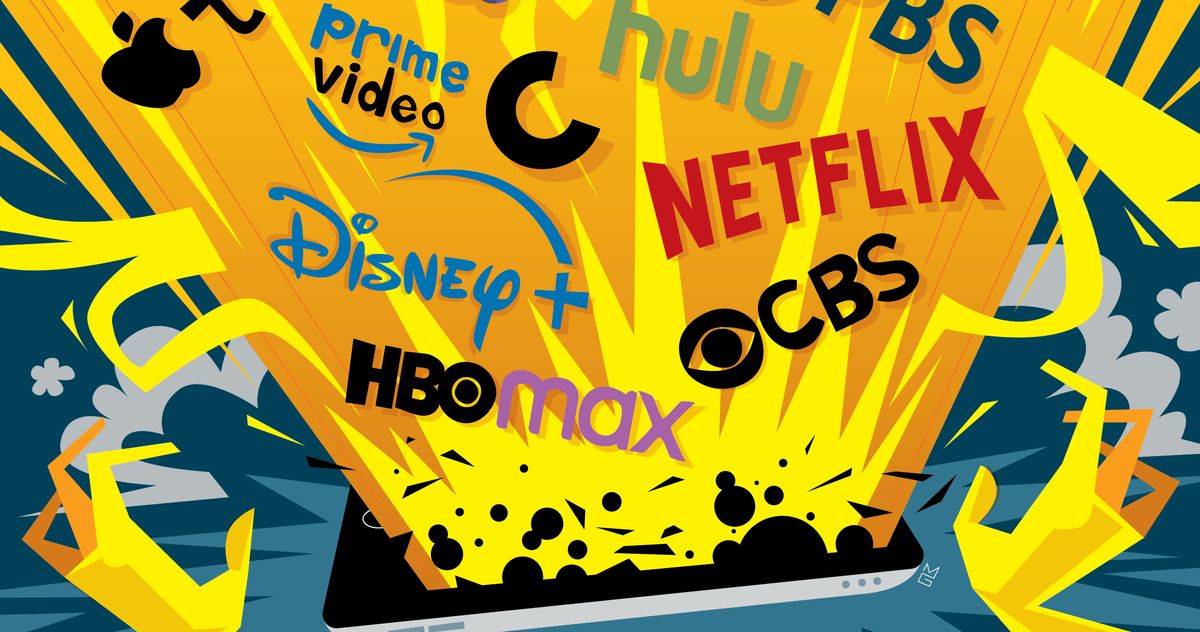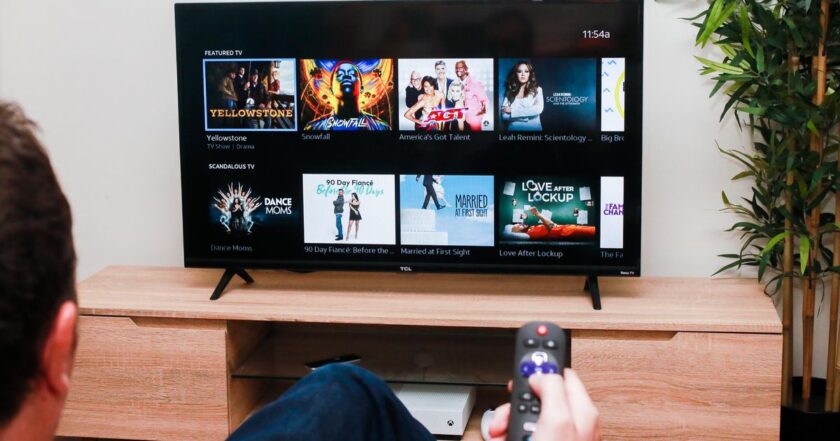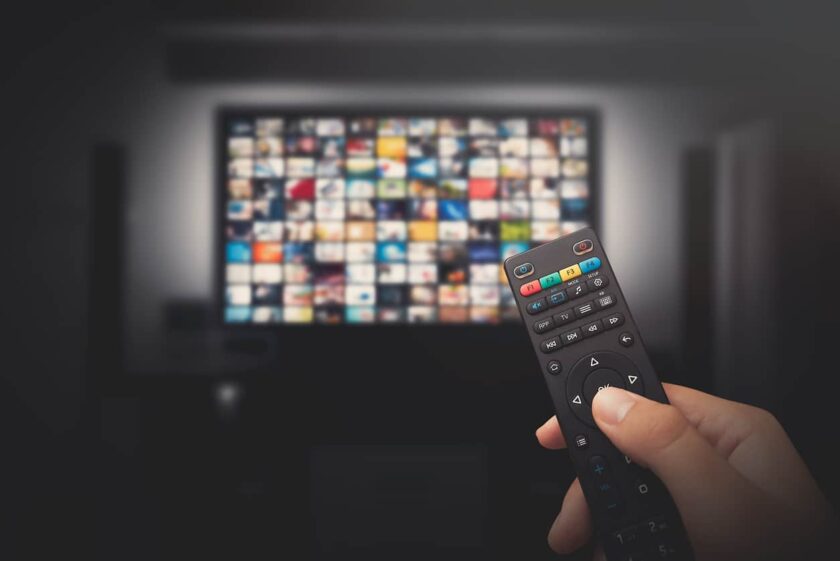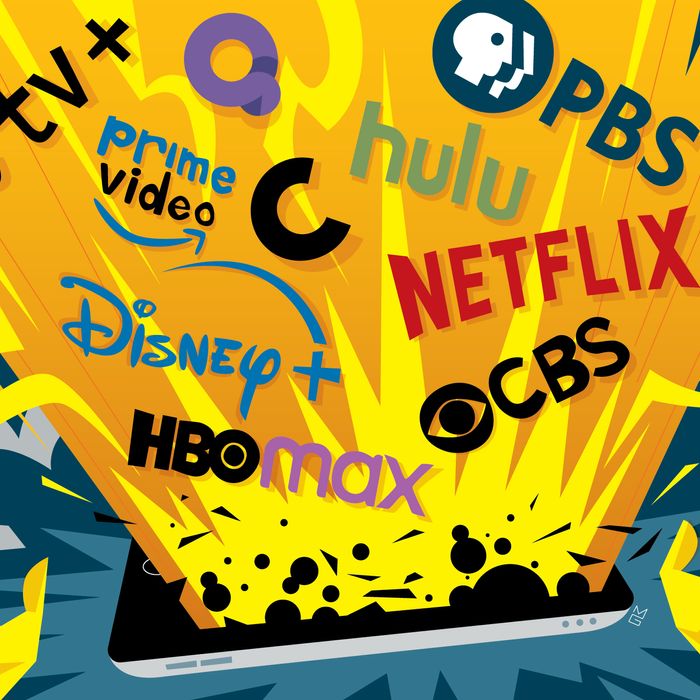
There are dozens of streaming services these days, and some of them are even pretty good. Illustration: By Martin Gee
Finding something to watch on TV used to be as simple as turning on the set, flipping through a few dozen channels, and stopping when you stumbled upon something worth checking out. Even during the early days of streaming, you could count on finding most big shows and movies on one of the big three platforms (Netflix, Hulu, and Amazon Prime Video) or the digital versions of the big premium cable networks (HBO Now, Showtime).
But it’s not so simple anymore: Since late 2019, there’s been a barrage of new platform launches as big media companies scramble for position in the post-cable universe. Apple TV+ and Disney+ came online in November 2019, while Peacock began rolling out in select cities in April (with a planned national premiere in July). A supersized version of HBO called, appropriately enough, HBO Max debuts this week, while a revamped and rebranded CBS All Access is expected by late summer or early fall. All that on top of literally dozens of other smaller services and niche platforms for audiences with specialized tastes. Nobody ever said the streaming revolution would be cheap — or easy.
The good news is that, unlike cable, almost all streaming services let you try out their product before you have to fully commit. A seven-day trial is usually the minimum sampling period, but as competition heats up, some platforms have been giving away an entire month of service. Still, even figuring out which streamers to check out takes some digging — and that’s where Vulture has your back. We’ve put together a master list of dozens of subscription-based video platforms covering a range of interests, from movies and general entertainment to sports and education. We’ve tried to find streamers serving all sorts of tastes and communities both narrow and broad.
A few notes: We want this guide to help you decide how to spend your money, so we didn’t include any platform that was completely free or ad-supported (think Pluto or STIRR). Many services try to make themselves look a bit less expensive by setting their prices at, say, $6.99 instead of $7; we opted to round up to the next dollar when listing costs. And one pro tip: Your cellphone company might offer free or discounted service to a streamer (see: Sprint’s Hulu promotion or T-Mobile’s “Netflix on Us” offer), so check their websites, too.
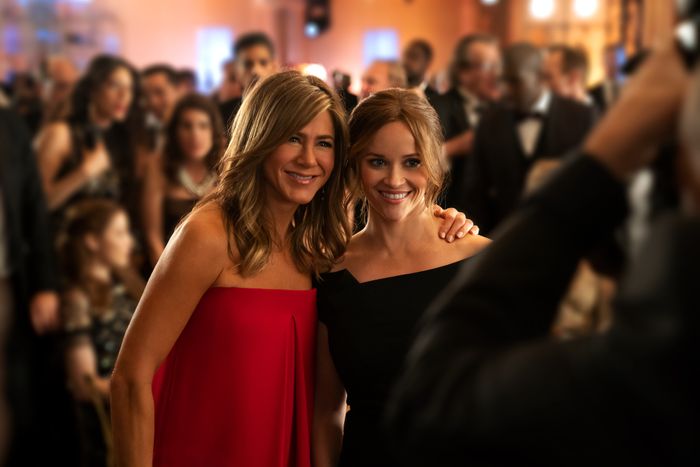
The Morning Show, available on Apple TV+. Photo: Apple
The everything store of original video entertainment is to streaming what Kleenex is to tissue: a brand so powerful it’s become synonymous with the category. Netflix spends billions each year making its own original scripted and unscripted series, dozens of stand-up comedy specials, and a yearly slate of theatrical-quality feature films bigger than any of the major movie studios. Basically, Netflix’s goal is to recreate a cable TV package in one place, offering enough highbrow and lowbrow programming to fill a couple dozen very different networks. Its library of older shows and movies has shrunk somewhat in recent years as Disney, NBCUniversal, and other competitors have reclaimed their intellectual property (translation: you can’t stream Friends or recent Marvel and Star Wars movies on Netflix anymore). But there’s still a decent-sized collection of retro goodness, including Cheers, Monty Python’s Flying Circus, Star Trek, and Grey’s Anatomy.
Cost: $9 per month/$13 per month HD/$16 4K
Though it doesn’t make nearly as many originals as Netflix, Amazon’s video service is no slouch when it comes to first-run fare: It usually premieres a couple of big tentpole comedies or dramas every month, from critical darlings (Fleabag, Modern Love) to crowd-pleasing hits (The Marvelous Mrs. Maisel, Bosch, Jack Ryan). Amazon simulcasts some Thursday night football games, too, and is also rapidly beefing up its first-run movie slate. It also boasts a far deeper collection of acquired movies and TV shows than Netflix, particularly if you’re looking for stuff from the 1970s and ’80s. And for better or worse, Prime also combines its subscription offering with stuff from Amazon’s video download and rental store: As you’re browsing through movies and shows included with the service, you’ll also be shown titles you can buy or rent.
Cost: $9 per month or included with an Amazon Prime subscription ($119 per year)
One of the few major streamers focused solely on original content, you won’t find a large library of older shows with hundreds of episodes to binge. Instead, Apple is looking to build its own collection of high-quality scripted dramas and comedies. The Morning Show, starring Reese Witherspoon and Jennifer Aniston, is the platform’s signature series, but other early standouts include the comedic Dickinson, theanthology Little America, a reboot of Amazing Stories,and the M. Night Shyamalan thriller Servant. TV+ also includes a few original movies, including a Beastie Boys doc and the Samuel L. Jackson film The Banker.
Cost: $5 per month/one year free with purchase of many Apple devices
The Disney-owned streamer is the best service if you’re a cord-cutter who still craves traditional TV: It offers next-day access to most prime-time shows from ABC, NBC, FX, Freeform, and Fox, plus its own medium-sized slate of original, generally well-reviewed shows (The Handmaid’s Tale, Little Fires Everywhere, Rami, Shrill, High Fidelity)and the occasional first-run feature film. In 2020, it also launched FX on Hulu, which combines most of FX’s past shows with exclusive offerings such as the limited series Mrs. America. Hulu also offers the ability to add on a live TV service with dozens of channels and the ability to record shows to a cloud DVR, plus options to subscribe to rival premium services.
Cost: $6 per month (with ads)/$12 per month (no ads) or $55 (with live TV); also available as part of a bundle with Disney+ and ESPN+ ($13 per month)
The only major streamer which offers a full broadcast service as part of the basic plan: Subscribers get access to the live feed of their local CBS station, including all NFL games. All Access also delivers current CBS shows for on-demand viewing (including news), plus a growing slate of originals such as The Good Fight, Star Trek: Discovery, Picard, and a reboot of The Twilight Zone. Library content is limited, though all the Star Trek series are represented. Expect much more content (first-run and classic) as owner ViacomCBS expands its streaming ambitions.
Cost: $6 per month (with ads)/$10 (no ads)
The happiest place in TV land for Disney fans, since virtually every major movie (animated or otherwise) can be found here. The focus is on tentpole Disney brands such as Marvel, Star Wars, Pixar, and National Geographic, as well as the company’s namesake family-friendly fare. Original content is still a work in progress, but this is the only place you can watch The Baby Yoda Show (sometimes known by its formal title of The Mandalorian). And if you have kids over the age of 2 and can afford the monthly charge, there’s probably no better electronic babysitter.
Cost: $6 per month/$70 per year; also available as part of a bundle with Hulu and ESPN+ ($13 per month)
With the launch of HBO Max, there are now two direct-to-consumer streaming services with HBO branding. (Sorry, nerds: HBO Go is only accessible if you pay for HBO through your cable operator.) So what’s the difference between them? Well, HBO Now, available since 2015, is the digital version of the iconic premium cable channel, serving up the full lineup of current and past HBO series, movies, and feature films available to cable and satellite customers. HBO Max replicates everything offered on Now, but adds in thousands of additional hours of classic movies (Casablanca, The Wizard of Oz, the Criterion Collection) and TV shows (Friends, The Big Bang Theory, The Fresh Prince of Bel-Air, South Park), plus a couple dozen original projects (an Anna Kendrick romantic comedy called Love Life, a reboot of Gossip Girl).
But the existence of these two identically priced platforms doesn’t mean you now need to subscribe to both. That’s because anyone who buys HBO Now automatically gets access to HBO Max for free, while anyone who signs up for HBO Max will, as noted, have access to literally everything available on HBO Now. AT&T, which owns both platforms, will gladly take your money if you sign up for both, but please, don’t do that. For 98 percent of streamers, Max is the right call: more content, same price. But if you’re an HBO purist who has a philosophical objection to the idea of The Sopranos and The Big Bang Theory sharing the same content row, then by all means, go ahead and subscribe to HBO Now. Just know that if for some reason you later decide you want to check out something on Max, you’ll be able to access it, too.
Cost: HBO Max, $15 per month; HBO Now, $15 per month
Its name is an homage to NBC’s peacock logo, and it is part of the same Comcast corporate family as NBC, so Peacock is really just NBC for streaming, right? Well, not really. It’s true that there’s a lot of NBC DNA in Peacock, including next-day reruns of some NBC primetime shows plus a library filled with stuff from either NBC (SNL, The Rockford Files, the Law & Order franchise) or Comcast-owned entities such as E!, Bravo and Oxygen. But in reality, Peacock is trying to be something closer to Hulu— a service for folks who like the kinds of shows on broadcast and cable networks, and don’t mind putting up with advertising if it means paying a lot less. So in addition to stuff borrowed from the various Comcast content libraries, you can watch back episodes of Paramount Network’s megahit Yellowstone, old episodes of George Lopez, Everybody Hates Chris, and The King of Queens, plus a decent (and ever-changing) selection of blockbuster movies. There are also Peacock originals, including an update of Brave New World and a thriller called Departure. You can even pretend you’re watching old school linear TV with Peacock’s Channels option, which lets users scroll through an on-screen program guide and join various programs already in progress.
Cost: A basic version is free to anyone, but doesn’t let you watch all Peacock originals and some big library titles. Peacock Premium includes everything on the service and costs $5 per month unless you get your cable or internet via Comcast Xfinity or Cox. Ad-free Peacock costs another $5 per month.

Showtime’s Ray Donovan. Photo: Jeff Neuman/Jeff Neumann/SHOWTIME
The digital version of the decades-old cable network focuses mostly on original scripted series, including buzz magnets such as Billions, The Chi, and Black Monday, as well as long-running staple Shameless. There’s also a regularly refreshed selection of original documentaries, plus some news (The Circus, Vice) and talk (Desus & Mero) programming. And while breakouts such as Homeless, Ray Donovan, and The Affair have ended their runs, they’re all available in the deep library of former Showtime series still available to stream on the service. What you won’t find is a big selection of recent blockbuster movies. While some hits do find their way here (Hustlers and Green Book, for example), Showtime long ago opted to stop spending on big movie output deals in favor of making more of its own shows.
Cost: $11 per month
The MGM-owned cable network finally began offering a direct-to-consumer service in 2019, letting cord-cutters access the premium channel’s roster of movies and original series. In addition to a robust offering of recent and classic films drawn from the MGM library (duh) as well as studios such as Sony, Paramount, and Lionsgate, Epix has also been slowly building a roster of originals. Notable titles include a well-reviewed adaptation of Get Shorty, dramas Godfather of Harlem and Pennyworth, and for Downton Abbey stans still suffering withdrawal pains, the Julian Fellowes joint, Belgravia (a co-production with the U.K.’s ITV).
Cost: $6 per month
While it sometimes seems this service only exists as a delivery mechanism for new episodes of Outlander, the digital edition of the cable network does offer a lot more for subscribers. Other original series include 2020 crime drama Hightown and the expensive adaptation of American Gods, along with Latinx drama Vida. And while the blockbuster quotient on Starz has declined in recent years as some key movie output deals expired, there’s still a strong selection of high-profile recent releases such as Once Upon a Time in Hollywood, Zombieland Double Tap, and Think Like a Man. Classic TV fans might also wanna give Starz a gander: The network has the on-demand libraries of beloved shows such as Good Times, The Jeffersons, Party Down, The Bernie Mac Show, Knight Rider; old-school toons (He-Man and the Masters of the Universe, She-Ra, and Inspector Gadget); and lots of Westerns (Lonesome Dove, The Big Valley, Death Valley Days).
Cost: $9 per month

Find Coronation Street and other popular British shows on Britbox. Photo: ITV
What it is: An Anglophile’s best friend, Acorn caters to audiences who want (much) more British programming than you’ll find on PBS or BBC America, along with a decent-sized serving of shows from Australia, New Zealand, Canada, and France. Its lineup has some big hits (A Place to Call Home, Midsomer Murders, Murdoch Mysteries, and Doc Martin), plus exclusives such as Miss Fischer’s Murder Mysteries, Dead Still, and Agatha Raisin.
Cost: $6 per month/$60 per year
An Anglophile’s other best friend, this streamer draws heavily on the libraries of two major British broadcasters, the BBC and ITV, to deliver a Thames-deep collection of current and past scripted programs (er, programmes) from across the Pond. Plus, the Britbox Now section of the service offers a ton of U.K. news (Good Morning Britain, Question Time), panel shows (Pointless, Mock the Week), and soaps (EastEnders, Coronation Street) almost as soon as they air in the U.K. The one downside: Because Amazon, Netflix, and HBO pay top dollar for the U.S. rights to blockbusters, some of the most buzzy British shows aren’t here.
Cost: $7 per month/$70 annually
Dramas, variety shows, and K-pop programming drawn from the libraries of three big Korean TV networks (that also happen to jointly own the service). Beyond a rich collection of VOD titles, the platform also has Taste24HR, which streams shows airing on linear TV in South Korea a day after their original broadcast (sort of like Hulu does in the States.) And you don’t need to speak Korean to enjoy: Most shows have English-language subtitles.
Cost: $1 per day/$7 per month/$70 annually
If you’re looking for a broad range of international series, with an emphasis on European countries, this service programs more than 2,500 hours of drama, comedy, and mystery series, all with English subtitles. There’s a mix of older titles as well as new releases, including the Spanish import Arde Madrid: Burn Madrid Burn (featuring Younger’s Debi Mazar); French mystery Les Secrets; and Norwegian crime drama Twin, featuring Game of Thrones regular Kristofer Hivju (a.k.a. Tormund). You can sample some programming (with ads) via the platform’s free MHz Now service, too
Cost: $8 per month/$90 per year
Studios Lionsgate and Pantelion Films are behind this Latinx-centric streamer featuring premium scripted series and about 300 Spanish-language movies (including some that have run while still in theaters in Mexico). Programming is a mix of acquisitions from other countries (including Drunk History: Mexico) and originals such as Ana and Vota Juan.
Cost: $6 per month
A massive library of Bollywood productions (10,000 hours’ worth), plus the ability to watch content in multiple regional Indian languages plus dozens of live channels of Indian TV.
Cost: $5 per month/$50 per year
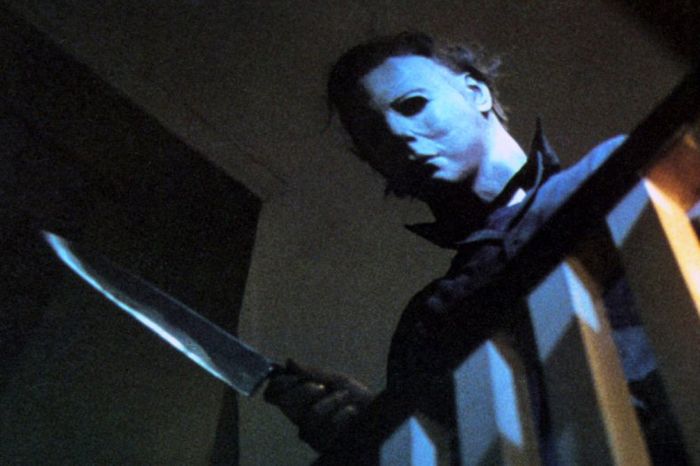
The original Halloween, available to stream on Shudder. Photo: Aquarius Releasing
The horror, the horror — plus thrills, chills, and all the things that go bump in the night are the stars of this AMC Network–owned streamer devoted to scaring the heck out of its subscribers. Beyond some of the big titles of the genre (the Halloween and Friday the 13th franchises are well-represented) and cult favorites (Class of 1984, Sorority Babes), the service offers premium, scripted original movies and shows, including a series remake of Creepshow.
Cost: $6 per month/$57 per year
We’ll be adding more sports options to this list soon, but in the meantime, this is the big one that should be on your radar. The most important thing you need to know is that ESPN+ isn’t a way of getting ESPN without paying for cable. It’s an add-on platform for fans who want extra coverage of sports like tennis and soccer, more UFC and boxing, plus the ability to dive deeper into ESPN’s catalogue of original programming, including the full 30 on 30 library.
Cost: $5 per month/$50 per year or bundled with Hulu and Disney+ for $13 per month
What it is: The digital reincarnation of the groundbreaking 1980s music-and-culture TV series serves up a deep library of amazing artifacts from the 1970s–1990s, and the variety is impressive. Beyond a selection of complete episodes, you’ll find everything from midnight movies (Desperate Teenage Lovedolls, I Was a Zombie for the F.B.I.) and music docs (Life on the V, Heavy Metal Parking Lot) to full episodes of Gumby and Dr. Ruth’s syndicated talk show.
Cost: $5 per month/$40 annually
What it is: The much-loved indie DVD (and, back in the day, music) distributor has put much of its video library online, serving up a great assortment of 20th-century cult TV shows and movies. Tentpole titles include Mystery Science Theater 3000 and old episodes of The Tonight Show Starring Johnny Carson (sadly, minus musical guests), but where the service shines is with smaller gems such as the Dean Martin Celebrity Roasts, The Weird Al Show, Fridays, and Space: 1999.
Cost: $3 per month
A big chunk of the Warner Bros. and Hanna-Barbera cartoon libraries lives here, including shows from Toontown patriarchs such as Fred Flintstone, Bugs Bunny, Yogi Bear, Papa Smurf, and Scooby Doo, plus honorary daddy Captain Caveman. There are also a few modern series, including Juniper Lee and Camp Lazlo. Perfect for baby boomers and Gen-Xers looking for a nostalgia fix or a way to school their kids and grandkids on the concept of “Saturday morning cartoons.”
Cost: $5 per month/$40 per year
The streaming home of the iconic comics brand curates hundreds of hours of DC-branded TV shows and movies, though don’t expect a complete library collection. The 1989 Batman and its 1992 sequel are here, but not the 21st-century reboot. You can watch the 1990 TV version of The Flash, but not the CW’s more modern interpretation (or any of the current CW superhero series). There are also a couple of original series, including Titans, Harley Quinn, and Doom Patrol. Still, it’s also the only streamer that comes with access to thousands of online comics.
Cost: $8 per month/$75 per year
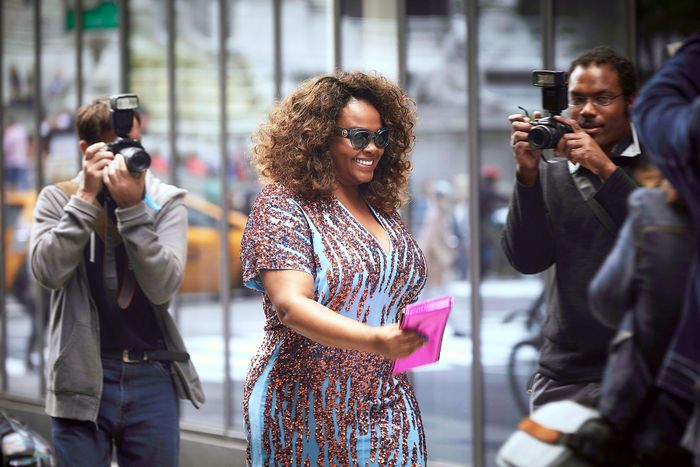
BET+’s First Wives Club. Photo: Karolina Wojtasik/BET
The decades-old cable channel has teamed up with Tyler Perry for a platform that offers both ad-free versions of the network’s TV lineup, large chunks of Perry’s movie and TV libraries, and a handful of exclusive series (such as Ruthless and a reboot of First Wives Club). And for classic TV fans, there are reruns of Martin.
Cost: $10 per month
Linear network Bounce TV’s digital hub collects hundreds of blaxploitation movies (including the original Dolemite) with ad-free versions of shows such as Saints and Sinners and a decent-sized library of more recent movies and specials featuring African-American talent.
Cost: $4 per month
The AMC Networks–owned streamer is devoted to shows and films created by or starring people of color, including originals such as Monogamy and A House Divided. There’s also a sampling of unscripted shows from WE tv (Growing Up Hip Hop) and OWN (Black Love).
Cost: $5 per month/$50 per year
An indie streamer with content from black creators, both in America and across the African diaspora. Movies from Nigeria (Flower Girl) live next to American docs such as Changing Face of Harlem. Programming categories range from news and docs to comedies and anime, plus plenty of international films.
Cost: $6 per month/$50 per year
Indie movies and docs, along with a selection of series (like the thriller Wicked Enigma), from and for diverse audiences, including people of color and the LGBTQ+ community.
Cost: $5 per month/$50 per year/$4 per month for film students
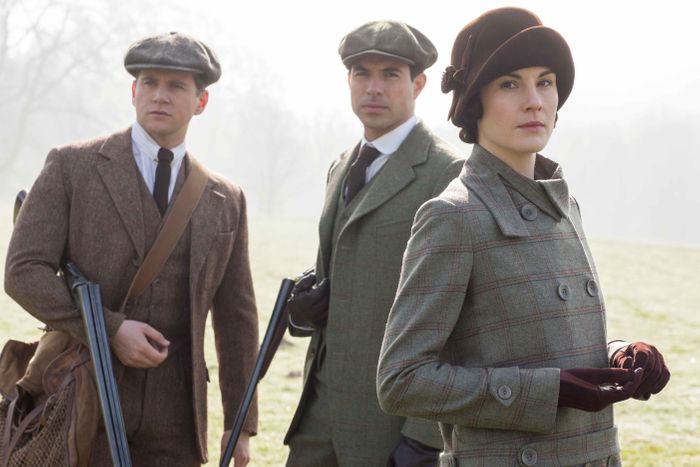
Downton Abbey, streaming on PBS Passport. Photo: Nick Briggs/Carnival Film & Television Ltd
It’s all (or at least most of) the goodness of PBS, now on demand. While PBS makes a good deal of current content available to stream for free via its app, you need to have the Passport service to stream past episodes of drama faves such as Downton Abbey and Poldark. You’ll also find dozens of unscripted shows, including Nova, Frontline, and American Experience, as well as programming from your local PBS station. (By the way, if you want kids’ programming, check out the free PBS Kids video app and website. And if you’re in the Amazon Prime Video ecosystem, you can also check out PBS Masterpiece, which is pretty much the same as Passport, with some added content. For more on PBS Masterpiece, see our entry on Walter Presents.)
Cost: Instead of a set price tag, you just have to make a monthly or annual contribution to your PBS station, which also determines how much that donation needs to be to grant Passport access (though $5 per month is usually enough).
The direct-to-consumer version of the ViacomCBS-owned cable network lets audiences stream thousands of hours of documentaries in all the major educational categories (nature, pop culture, history, science). If you’ve already got Smithsonian via cable, the only upside of the service is the lack of ads.
Cost: $5 per month
You’ve probably seen one of the omnipresent ads, but in case you haven’t: It’s basically a reincarnation of what Discovery Channel and TLC used to be before they got heavily into reality shows — educational and feel-good fare focused on nature, history, science, and technology. (Not surprisingly, the man behind CuriosityStream, John Hendricks, founded Discovery Networks a few decades ago.) And while most of the content isn’t specifically made for kids, its educational bent makes it perfect for parents looking to keep the kiddos engaged and educated.
Cost: $3 per month/$20 per year (but $12 per year through mid-May)

The 400 Blows is among the many classic art-house film available on The Criterion Channel. Photo: Zenith International Films
Fans of French New Wave cinema, rejoice. One of the biggest brands in art-house cinema curation has a streaming platform worthy of its namesake: More than 2,000 titles (big ones, not the obscure stuff — though there’s plenty of that, too) plus expertly crafted collections, behind-the-scenes extras, and original documentary series such as Art-House America and Adventures in Moviegoing.
Cost: $11 per month/$100 per year
It doesn’t get more indie than this crowdsourced film and TV incubator, which help creatives fund their projects (including this eerily prescient one about a family sheltering in place to avoid a mysterious germ) and then gives them a platform to be seen. The Seed and Spark streaming service includes a robust collection of movies, shorts, and documentaries, with nary a blockbuster to be found. “A streaming library selected by film-loving humans instead of algorithms,” the site’s sign-up page promises, leaning into the Netflix shade. It’s available to watch via laptops, mobile, or Roku app.
Cost: Pay what you can (though there’s a $3 per month minimum)
The platform offers a modest rotating library of films that fit into its mission statement to promote projects which “foster diversity, understanding and empathy across societies and borders.” You’ll find everything from French art-house films (Café de Flore) to the acclaimed Israeli doc Rabin, the Last Day. Expect at least one new title every week, and monthly virtual festivals devoted to themes such as “In Transit” (movies about refugees) or “Teenage Wasteland”(an examination of life for contemporary young adults).
Cost: $5 per month/$50 per year
A quirky streamer owned by the U.K.’s Channel 4 that’s devoted to international dramas, with Italian producer Walter Iuzzolino personally curating the service’s selections. While it started out as a stand-alone app, Walter Presents now is a bit harder to get. You’ll need to have a Roku player or a Comcast Xfinity subscription in order to get the full service, which generally features about 60 different titles. Alternatively, you can get much of the Walter Presents programming as part of a subscription to PBS Masterpiece, an Amazon Channels service which also throws in a ton of content from the public broadcaster.
Cost: $6 per month
Tired of scrolling through endless rows of movies and not being able to pick one? This cinephile-centric service solves that problem with curation: It premieres and deletes one title every day, giving subscribers about 30 releases to watch each month. (Mubi even attaches a label to each title letting you know how many days are left before it disappears.) Programming ranges from 1940s classics (Jean Renoir’s Oscar-nominated The Southerner) to recent Cannes films (Si Ling Hun’s 2018 film Dead Souls).
Cost: $11 per month/$96 per year
A collaboration of Music Box Films and Doppelgänger Releasing, this platform features dozens of art-house movies and a handful of series from around the world.
Cost: $5 per month/$50 per year
Hundreds of library titles from the IFC Films, IFC Midnight and Sundance Selects banners are collected here, including the Trip series and Boyhood (both of which are exclusive to the platform), plus the directorial debuts of films from Barry Jenkins, Lynn Shelton, Steve McQueen, Lena Dunham, Andrea Arnold, Jennifer Kent, Noah Baumbach, Greta Gerwig and The Safdie Brothers. It’s available via the Apple and Amazon channels programs.
Cost: $6 per month
A streaming offshoot of the cable channel, with a nice assortment of international series (everything from Deutschland 83 to the underrated comic gem that is Rosehaven), true-crime docs, and feature films.
Cost: $7 per month/$60 per year
Independent, international cinema that’s hard to find on streaming finds a home on this platform, which boasts thousands of titles from smaller studios and distributors such as Bullfrog Films, Women Make Movies, and First Run Features. The content is an intriguing mix of documentaries and arthouse-type movies (current and classic). The stuff you read about in The Nation or Mother Jones, or which gets reviewed on page 16 of the New York Times Arts section, is probably here.
Cost: $7 per month
The 18-year-old distributor, which started out in 2002 with a monthly DVD club, now has a streaming service offering more than 300 indie titles and dozens of short films. The titles are often award nominees (and winners), festival faves, and foreign-language hits. In addition to on-demand movies, the service also allows you to buy or rent more recent releases.
Cost: $6 per month/$60 per year

Kinky Boots. Photo: Matthew Murphy
If you never got the chance to see the 1981 staging of Pippin (with Ben Vereen and Greatest American Hero star William Katt!) or Cathy Rigby in the revival of Peter Pan, this is your platform. While it’s not quite the Netflix of stage shows, there are still dozens of interesting plays, musicals, concerts, and documentaries packed into Broadway HD, and they’re all commercial-free. And while a lot of the content is retro, there are some modern hits, too, such as the latest production of Kinky Boots.
Cost: $9 per month/$100 per year
A handful of recorded-live productions is supplemented by a growing catalogue of original productions for theater nerds or those who are just theater-curious, including the comedy series Smash’d and the talk show Crossovers. There’s also a decent selection of dance programming, documentaries, and programming about performers and performances, such as 1982’s American Playhouse presentation of Who Am I This Time?, with Christopher Walken and Susan Sarandon as community-theater actors.
Cost: $5 per month/$50 per year
CutCableGuy.com